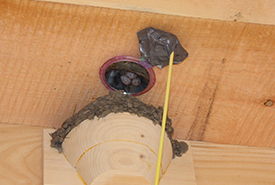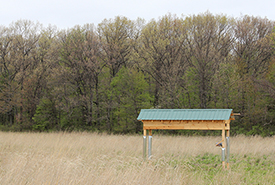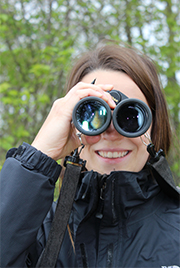Deciphering the nesting behaviour of barn swallows: What are THEY looking for?

Three barn swallow eggs spotted during a nest check in spring 2014! The nest cup edges and interior area are built up with mud pellets and beautifully lined with feathers. (Photo by Carolyn Zanchetta)
The unique song, fantastic flight pattern and beautiful colouration are just a few of the many wonderful features of the barn swallow that make it a favourite species to many bird watchers — myself included.
Barn swallows are the most widely distributed of all swallow species and live in very close proximity to us; nesting in human-made structures such as barns, sheds, bridges and culverts. Nesting in suburban and rural backyards, while foraging over open fields and ponds, makes this species an especially appreciable species and also very accessible for monitoring!
Despite how close we interact and overlap habitat with these aerial insectivores we still know very little about them. What exactly are they looking for when choosing a nesting site? What do they require from a nesting site for successful reproduction? These are very important questions we have yet to find a definitive answer for.
It is shocking to learn that the barn swallow population in Canada has been designated as threatened, by some reports having declined by close to 80 per cent in the past 40 years. This is especially alarming to those living in rural and agricultural areas who are accustomed to having vast amounts of barn swallows inhabiting their fields and barns.
There are many possible reasons for the persistent decline of the barn swallow (and all aerial insectivore species in general), including a change in insect populations, extreme weather events, changes in overwintering grounds and changes or reduction in nesting habitat. We are continuously altering the design, construction and building material of our barns and bridges. Considering the main nesting sites of barn swallows are these are human-made structures, it is important for us to determine what exactly they prefer in a nesting site to mitigate any changes we make to their current habitat.
This is exactly what Bird Studies Canada (BSC) is working towards.
BSC has teamed up with the Nature Conservatory of Canada (NCC) to test the success of artificial nesting structures. The goal is to determine structure features that lead to the greatest occupancy and nesting success, and to develop an optimal structure design that can be used as an effective mitigation strategy for barn swallow habitat loss across Ontario.
Four structures were installed in the spring of 2013 in various habitats. In the spring of 2014, an additional four, slightly modified, structures were installed on two NCC properties (Backus Block and Central Big Creek Block). These nesting structures provide ledges, nest cups, visual barriers between nesting areas and protection from weather and predators. They are located in areas where swallows have previously occupied a structure that is no longer available.
Additionally, this year we are looking into the effects of social attraction on nest site choice by having one of the two structures at each site equipped with decoys and auditory playback. These structures are a potential mitigation strategy for any landowner that is making changes to their property and looking for ways to keep our friendly neighbourhood swallows around.

The 2014 artificial nesting structure design equipped with cross bars and nesting cups, privacy barriers, metal barriers to protect from mammalian predators. (Photo by Carolyn Zanchetta)
The results of this project will shed light on what exactly the swallows look for in a nesting site and why they are choosing one site over the other.
So far this year we have three pairs of barn swallows nesting on the NCC properties, and one nest has successfully hatched! Barn swallows often scout out next spring’s nesting site before fall migration so we are hoping that next year’s occupancy of the structures will be even higher!
For the spring of 2015 BSC is looking to locate five additional sites to install these artificial nesting structures in order to continue expanding our knowledge and understanding of barn swallow nesting behaviour, further our development of ideal habitat loss mitigation strategies and aid in rebounding the barn swallow population.
If you are interested in hosting artificial nesting structures on your property, please contact Kristyn Richardson, stewardship biologist at krichardson@birdscanada.org or 519-586-3531 ext. 127.
If you are already hosting barn swallows, please monitor the nests and submit observations to Project NestWatch at http://www.birdscanada.org/volunteer/pnw/.
This information is critical to monitoring any population changes and is also a great way to stay connected with the barn swallows themselves!


